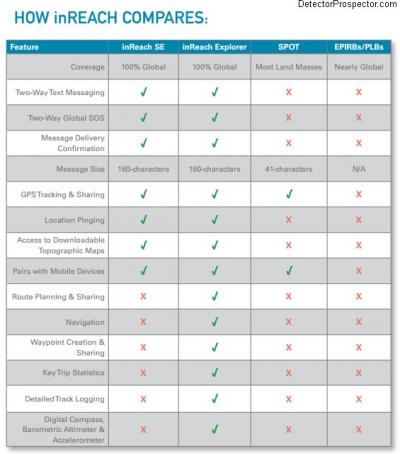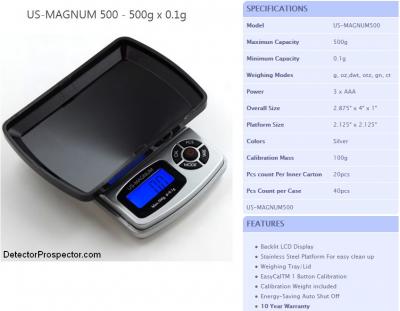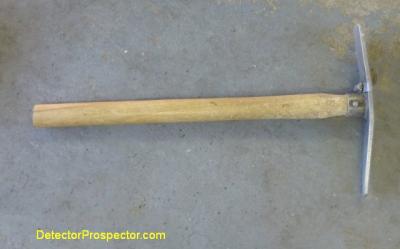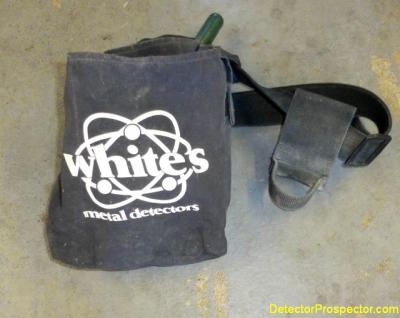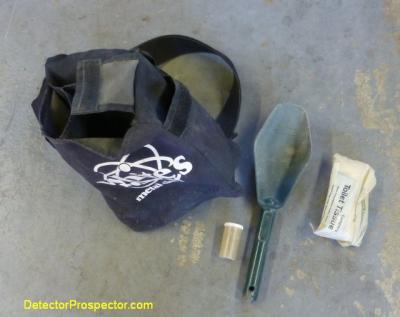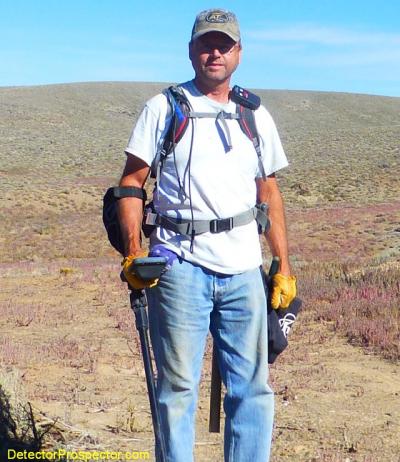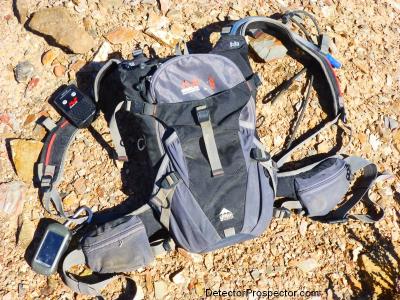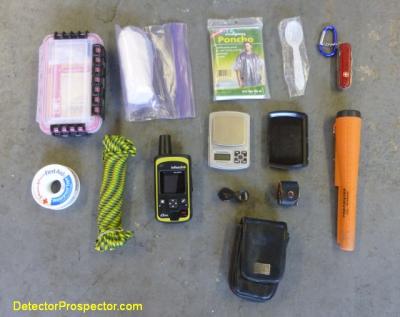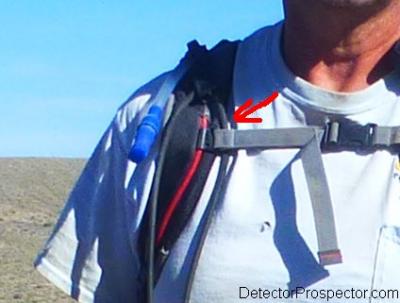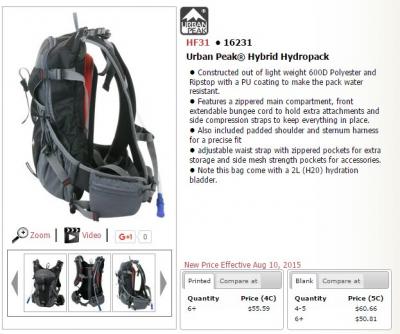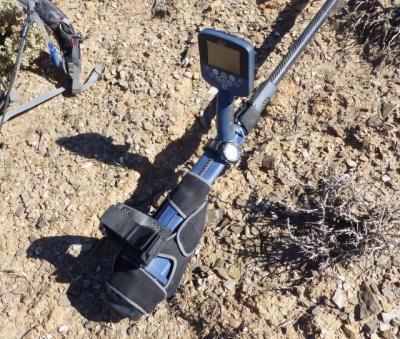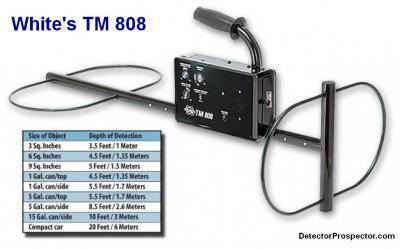-
Posts
19,794 -
Joined
Content Type
Forums
Detector Prospector Home
Detector Database
Downloads
Everything posted by Steve Herschbach
-

Nokta FORS Calibration?
Steve Herschbach replied to spencer@wy's topic in Nokta / Makro Metal Detectors
Cell phones absolutely can and very often will cause problems. I would not worry much about a single outing. Just go out again and give it another go in a different location, and leave the cell phone behind or at least turned off. -

Nokta FORS Calibration?
Steve Herschbach replied to spencer@wy's topic in Nokta / Makro Metal Detectors
Cost of a "tune up" would simply depend on the manufacturer. In many cases postage costs may be the majority of the cost. As a rule my detectors either work or they do not. In 40 years and countless detectors I only ever sent one in once to get "tuned up". The odds are pretty low of a detector needing this. If a detector is consistently causing you to think something may be wrong with it, then sending it in to get checked out might be a way to set doubts aside. Most of the modern digital type detectors have very little that can be calibrated, but many older analog designs have numerous internal settings that can be adjusted and that may therefore be out of adjustment. I do not think the GMT is a detector that has any history of calibration issues. Other detectors, like the Fisher CZ series, are kind of famous for it. Tom Dankowski has a little sideline business testing and calibrating Fisher CZ detectors for people. Analog models were often tuned at the factory for the particular coil they shipped with. The one I sent in was a Fisher Gold Bug 2. I got a different coil for it (a smaller one), and sent it in to get the detector specifically tuned for use with that coil. Most Tesoro detectors out there are tuned for the coil they ship with, and making another coil the primary use coil would be a reason to consider getting it retuned. Keep in mind also that when detectors do end up misbehaving, in the vast majority of cases it is a coil and cable issue, not the control box, that is causing the problem. Long story short I wish I had a better answer. It is pretty obvious when a detector goes truly haywire. Determining if a detector is just a bit off is a whole different problem. You could compare air tests on a nickel or dime with other people on the Internet, but frankly that would probably be frustrating also. People interpret what a signal is at fringe distances with considerable variation. I tend to be conservative and note clean, solid, repeatable signals as being what I would quote. Others note the faintest hint of a whisper of a signal as their number. The difference between what I would quote and somebody else would quote air testing the same machine could be measured in inches. All I have ever done with my detectors is just wave something under the coil. If it goes beep, I go detecting. It is entirely possible I have owned detectors that were consistently one inch shy of where they should have been and never knew it. It no doubt does happen with machines that are out there, but unless a person has access to a second identical machine it would be very hard to know. -
I have a bunch of picks but you will have to wait a couple days for a picture and commentary. Kind of busy right now.
-

First Nugget With GPX 5000
Steve Herschbach replied to calihunter4au's topic in Detector Prospector Forum
Absolutely great idea Scott - I should have thought of that! Rye Patch Nugget Shoot Information -

First Nugget With GPX 5000
Steve Herschbach replied to calihunter4au's topic in Detector Prospector Forum
I honestly think you are better off nearer to home. Lots of gold near you whereas Rye Patch is beat to death. I admit I do enjoy wandering the desert more than most anything however. In California I spend most of my time digging nails. In Nevada it is more like Australia where you go for ages with no targets at all, but if you get one a good chance it might be gold. The GPX is pretty forgiving, main thing is to just get out and use it. Beginners Guide To Minelab GPX 5000 -

My Nugget Detecting Kit
Steve Herschbach replied to Steve Herschbach's topic in Metal Detector Advice & Comparisons
Good question. The Delorme InReach has a big edge over the Spot due to the InReach having two way messaging. I updated my thread on the subject at Delorme InReach Satellite Text Communicator with the answer to your question. Short answer - highly recommended. -

DeLorme InReach Satellite Text Communicator
Steve Herschbach replied to Steve Herschbach's topic in Detector Prospector Forum
Well, I finally activated my InReach account. There is a one time activation fee. After that, you choose the level of service you want (number of text messages per month). The key thing is the service is by the month and can be activated when you need it, or the account put on hold indefinitely when you do not. The basic plan is only $15 per month http://www.inreachdelorme.com/product-info/subscription-plans.php That only gives me ten text messages sent or received, but the unit allows you to send a few preset messages in unlimited numbers. I created some like "arrived safely", "on way home", and "delaying return". These can be sent to email addresses or as phone texts. I sent one to my wife's email just to make sure it worked and it did just fine. All good as far as I can see and so I sold my satellite phone to a friend. I highly recommend the Delorme InReach for anyone spending much time outside cell range. The minimal cost per month and ability to send two way messages make it a great option. The simple way to look at it is this. The other options let you send for help in an emergency. That is good. But what about an emergency at home? This lets my wife know she can reach me if need be at any time. She can send me a text message. The catch is I have to look for it, an so every morning and evening I check the InReach to see if I have any incoming messages. Otherwise I leave mine off to conserve battery power. Delorme InReach Color Brochure -

First Nugget With GPX 5000
Steve Herschbach replied to calihunter4au's topic in Detector Prospector Forum
Welcome to the forum. That is a nice fat nugget, the kind I like to find. Congratulations! -

GPZ And SDC Gold From California
Steve Herschbach replied to Reno Chris's topic in Detector Prospector Forum
You are doing great Chris - keep it going!- 20 replies
-
- gold found
- minelab sdc 2300
-
(and 1 more)
Tagged with:
-

My Nugget Detecting Kit
Steve Herschbach replied to Steve Herschbach's topic in Metal Detector Advice & Comparisons
Plenty of bears in Alaska! I spent a lot of time in very remote areas by myself and with no communications. Anything that happened, it was totally on me. In those situations I often packed a bear gun (12 ga pump) but never actually had to use it to defend myself. I saw lots of bears over the years but they had no more interest in trouble than I did. Mountain lions? Now those are spooky. I will take bears any day. I have had so few detector parts failures in 40 years it is not something I worry about much, except for spare batteries. With the SD/GP/GPX I always had a spare coil bolt and battery cable. The GPZ lacks both those items. -

My Nugget Detecting Kit
Steve Herschbach replied to Steve Herschbach's topic in Metal Detector Advice & Comparisons
Cover for the scale that doubles as a weighing tray. Normally clips over top of the scale. It is an older version of the US Magnum 500 -

My Nugget Detecting Kit
Steve Herschbach replied to Steve Herschbach's topic in Metal Detector Advice & Comparisons
They apparently are made just to be used as promotional items like Minelab did. A couple outfits offer to sell singles as "samples" though. http://www.motivators.com/Promotional-Custom-UrbanPeakHybridHydropack-90166.html? I like mine enough I may just try and get another for when I wear this one out. Lots of other pack options out there however. -

My Nugget Detecting Kit
Steve Herschbach replied to Steve Herschbach's topic in Metal Detector Advice & Comparisons
Hi Ivan, The number one difference for me from my days in Alaska is how close I can get to most stuff with my 4-Runner. In Nevada I am often parked 5 minutes away!! But I do like to go on walkabouts and the program there is to go that way for a couple hours before looping back to my vehicle so I often get a couple hours detecting distance from the rig. But that is swinging the detector. Actual distance would almost never be more than a couple miles from my truck. -

My Nugget Detecting Kit
Steve Herschbach replied to Steve Herschbach's topic in Metal Detector Advice & Comparisons
Hi Tom, Yes, that is the Garrett AT Pro Pointer. No advantage in being waterproof in the desert per se but being environmentally protected can't hurt. So far it is my all time favorite pinpointer. -
I am not saying my way is the best or anything like that, but I figure for newcomers at least some idea of what a person might need detecting would be helpful. Click images for larger versions. Steve in the field This is what I look like out detecting. In Alaska I would probably be in a rain jacket and mosquito headnet but things are a bit nicer down south! Main thing to note here is I am using a small camelback style rucksack which serves three purposes. It is my detector support harness, it contains some essential items, and it gives me a quick sip of water when I need it. The GPZ 7000 bungee clips to my right shoulder next to the water tube. The speaker module goes on the left shoulder under my good ear. I pretty much always use the module unless wind forces me to go to headphones. The bungee wanted to pull off my shoulder but I found a simple solution by routing it under the cross strap that connects the shoulder straps. I use the standard GPZ 7000 velcro/clip on the detector itself to attach the bungee. I really like how easy it is to disconnect from the detector while digging, etc. which is also facilitated by the remote speaker. Closeup of bungee routing The rucksack is a freebie I got at the Minelab convention a couple years ago (thanks Minelab). It is an Urban Peak Hybrid Hydropack with 2 liter water capacity and for a item I got quite by chance it turns out to be about perfect for me and my use. My rucksack/bungee harness I use the GPS system built into the GPZ 7000 pretty religiously these days but still am also using my Garmin GPS which is clipped to my left shoulder strap for easy access. You can see in the right hand belt pocket the GPZ 7000 ferrite ring ready to use if I ever need it. Here are the contents of the rucksack: Items in the rucksack The waterproof container in upper left has basic first aid supplies, bandaids, pain killers, moleskin, lighter, emergency blanket/tarp, etc. Next is a plastic baggie with emergency toilet paper. Then a cheap plastic disposable poncho in case I get caught by a sudden downpour. A plastic spoon and a Swiss Army knife. Next row some waterproof first aid tape good for lots of things. Some parachute cord. A Delorme InReach emergency satellite communications device. A digital scale with cover and 10X loupe/magnifier with cover. A Garrett AT Propointer and finally, my camera. Often a spare GPZ battery or food or other items join this stuff but these are the items always with me. I have long been a fan of the White's belt pouch (P/N 601-0066 $14.95). It has three main compartments and two little side compartments with velcro closures. The largest main compartment gets all the trash I find. A smaller compartment has my gold bottle and maybe my camera or a water bottle. The third compartment is a holster for my digging scoop. One of the two side compartments has more emergency toilet paper (can't have too much) and maybe spare AA batteries if I am using a VLF. The belt is nothing special just a nylon utility belt. It has a nylon pick holder mounted to hold my pick when I am not actually using it. Trash and goodie pouch with side compartments Finally, the pick. In Alaska I hunted tailing piles a lot and so favored picks with big hoe digging implements. Now with the GPZ I want the metal at a minimum and I find I do not need a digging hoe so much in the desert and such down south. So this is a Hodan 24" digging pick which does all I need. It has a super magnet stuck on the head, with a small hose clamp placed ahead of it that keeps the magnet from sliding off when I dig aggressively. Digging pick Oh yeah, the gloves. I always wear gloves to protect my hands when digging and just in general. I have had people comment that some of my photos must be staged because my hands are always clean! Anyway, that's about it. I am going to put my camera in a pouch on my left shoulder right under the speaker module so it is always handy. I saw a bunch of antelope recently and the camera was in the rucksack. No good as sometimes you only get seconds for a good photo. Other than that I am pretty happy with my setup. Like I said, it is not what everyone needs and lacks some things some people might need, but it at least offers an idea and suggestion for things to consider. Urban Peak Hybrid Hydropack
-

GPZ 7000 Hidden Clock Function
Steve Herschbach replied to Steve Herschbach's topic in Minelab Metal Detectors
I bought several cheap watches at Walmart (big display, waterproof) and all my detectors now wear one. -

GPZ 7000 Hidden Clock Function
Steve Herschbach replied to Steve Herschbach's topic in Minelab Metal Detectors
The post was fun but the reality is I have a different solution. I do not wear a watch personally, but all my detectors wear one. -

Rye Patch Nugget Shoot 2015
Steve Herschbach replied to Sourdough Scott's topic in Detector Prospector Forum
Wow, you got some major backing and promotion. I just got an email from Kellyco promoting the event... 3rd Annual Rye Patch Nugget Shoot Come out for a day of fun! You will have the chance to participate in a planned detecting hunt and see demonstrations of gold mining while learning about important contributions of the mining industry, in the state of Nevada. There will not be an entry fee into the park or to camp overnight! The metal detecting class for $5 per person will help you learn to hunt better and get a chance to see the Nokta FORS Gold and Minelab GO-FIND 60 in action. Classes and demonstrations start at 9 am with the hunt lasting from 10 am to 3 pm. Be sure to get there early so you can grab one of 500 giveaway bags that Kellyco (that's us!) are providing! You could also be a lucky winner of one of the many prizes (total value of over $20,000) that will be given away during the day as well. Last year's event was a huge success and promises to be just as fun this year. What: 3rd Annual Rye Patch Nugget Shoot When: Saturday September 19th Where: 2505 Rye Patch Reservoir Rd. in Lovelock, Nevada 89419 -

Best Method Of Scanning Solid Rock
Steve Herschbach replied to OroSeeker's topic in Detector Prospector Forum
I have briefly demonstrated a TM 808 to find a water main. It is not normally used gold prospecting. More for finding fuel tanks, water mains, etc. and by "treasure hunters". Anyway, my advice is check out the Minelab GPX 5000 and its large coil options. Good luck! -
The Pro runs fine at full gain. Yes , it warbles. The warbles are not target signals. The warble is the threshold. Listen for non-warble noises - those are targets.
-
What s classic spectacularly awesome story. Thanks for taking the time tell tell it strick, and congratulations!
-

Best Method Of Scanning Solid Rock
Steve Herschbach replied to OroSeeker's topic in Detector Prospector Forum
Hello OroSeeker, As far as fonts go, do nothing and the forum defaults to Arial. You do not have to chose a font, just type away. Sorry if I came off harsh but I am just being honest. You predicated this idea on your mom being of failing health and your finances non-sustainable. I am looking at this from that perspective, the perspective of needing money in serious circumstances. From where I sit I have prospected for gold my entire life and am doing this literally as this thread develops. I was swinging a detector prospecting all day yesterday and will be doing so again in an hour for the entire day. And the next, and the next. I know intimately what we are talking about here. I am in good gold country swinging the most powerful prospecting detector currently available, a Minelab GPZ 7000. The country I am in has vastly more chances of my wandering over a shallow overlooked gold vein than Minnesota, where your chances are so close to zero as to be exactly that. Most of us are looking for gold nuggets because that is the best way to find gold with a metal detector, but the ground all of us swing over could also reveal shallow rich gold veins or pockets. They do get found from time to time, but they usually are the sort that give up a few ounces of gold as best. They are not some magic bonanza. I can recall one example in Austrlalia off hand where a vein found in Australia with a metal detector actually produced enough gold to make a difference in life. This is extreme long odds stuff. I do spend time, and in fact spent half the day yesterday on a walkabout looking for a new patch or a shallow gold vein. I do it all the time. I detect gold shed off of veins all the time. A gold vein in place is usually just a bunch of quartz with no gold to be seen, but if enough of the quartz decomposes over millennia a stray piece of gold is liberated now and then to create little residual deposits that can be worked with a detector. If you were with me right now I could drive you to and show you many in place gold veins. They are not the gold filled things I think you are imagining. They have gold measured in fractions of an ounce per ton. Rich gold veins the likes you seek exist mostly in the imagination. Again, your issue is not detectors of detecting methods, it is learning more about the nature and reality of gold veins and gold deposits in general. If you were just a casual person with some money to blow I would indeed say go for it. But the situation you have presented is different. You portray yourself as somebody with some serious issues that require some income. I would be doing you an extreme disservice in suggesting that chasing gold with a metal detector is a wise way to approach that issue. That is all I have to say on that subject. If you do just want to get into prospecting and metal detecting that is great, and we are here to help. -

Best Method Of Scanning Solid Rock
Steve Herschbach replied to OroSeeker's topic in Detector Prospector Forum
He was referring to the type face(font) in the original post, which was very hard to read. I have converted it to standard. I hate to dash dreams but I have done it a lot over the years. If you are looking to make some money, this is not the way to do it. At best, you are going to spend a lot of money getting an education. I can give you the same education for free. This is not something that thousands of people have not already tried. If dragging big coils around found gold veins than big mining companies would have crews out doing just that. Without getting into details the issue is simple. Detectors see the number of square inches or square feet of target as seen looking straight down. Here are the depths attainable with metal detectors on large items, whether a PI or specialized VLF. These are depths under perfect conditions in non-mineralized ground. Your problem is not the equipment, it is the nature and reality of how gold occurs in gold veins. It is normally near invisible to the naked eye. You would need masses of gold as large as the items in the chart to get similar depths. The sad reality is you are not going to be finding gold as large as one gallon cans and larger. Therefore, the depths that can be obtained on these large objects will not be attainable while looking for naturally occurring gold. Large drag coils are employed to look for single large gold nuggets and meteorites and could be employed in very specific area to possibly look for extremely rich gold veins at shallow depths. But it would have to be in the middle of world class gold country, like Australia or now Africa. And even then the odds of success are very slim. The TM 808 above is a VLF and as such cannot deal with high mineralization. The depths are likely to be half or less of those published in bad ground. Similar results can be had with a Minelab or other PI and very large coils in more mineralized ground. But the target size rule remains. Beware, you will find people willing to tell you otherwise if it involves parting you from your hard earned cash. -
Sorry to hear no gold. The GPZ runs hot and that is all there is to it. In some places that works against it. The SDC on the other hand is running a version of the GPX Smooth class of timings and will ignore rocks the GPZ hits on. The GPX will handle almost anything. I sold my GPX but my Garrett ATX serves the same purpose for me. It will tune out basalt that even a GPX cannot handle.
-

Some Beginner Advice And Field Training
Steve Herschbach replied to Robert F's topic in Metal Detector Advice & Comparisons
Both are excellent choices for the Anchorage area. The Gold Bug 2 has a minuscule edge on the tiny gold but the GMT punches deeper on big stuff so a bit of a trade there. If you are staying close to Anchorage I might lean Gold Bug 2 but for nugget detecton all over Alaska I think the GMT is the better choice. Can't really go wrong with either. Unfortunately no training I am aware of in Alaska but good news is none really needed. Just get out and dig everything that beeps.good luck!

